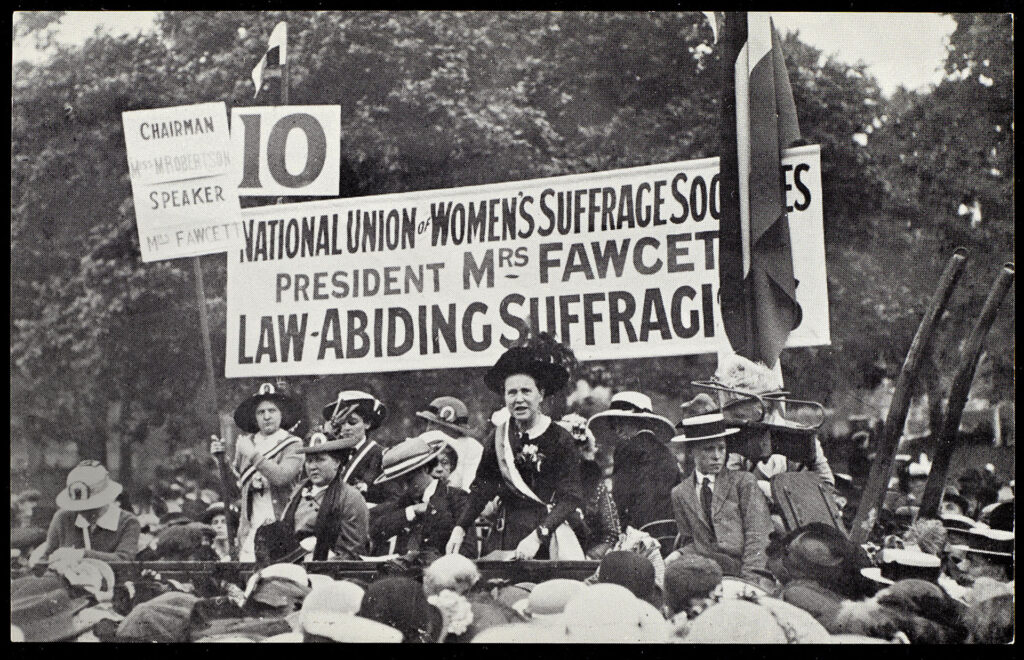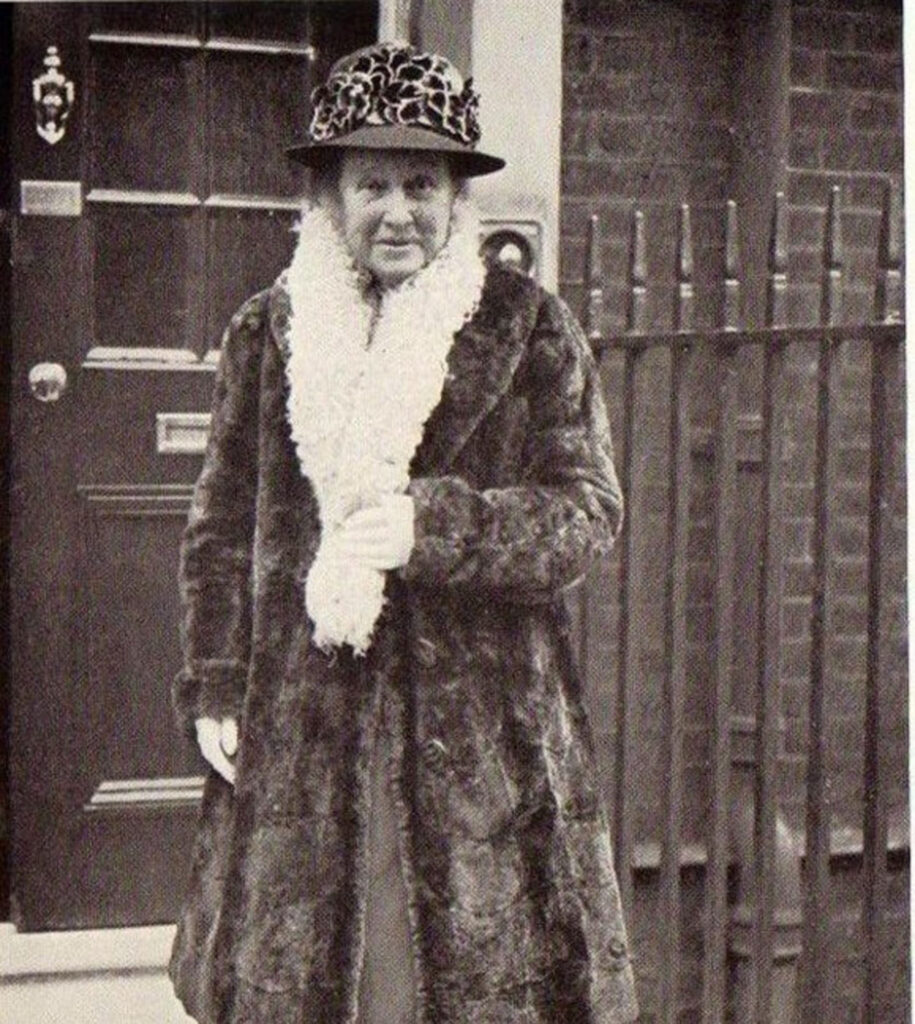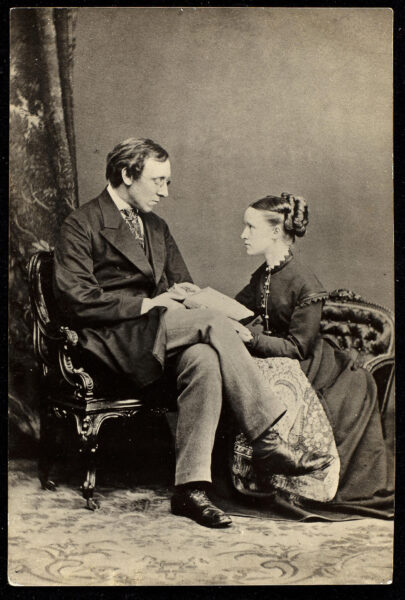Millicent Fawcett 1847 – 1929
Politician, feminist.
11 June 1847 – 5 August 1929
Millicent Garrett Fawcett: A Tribute by Elizabeth Crawford
Millicent Garrett (1847-1929) was born at Aldeburgh, Suffolk, one of the ten children of Louisa and Newson Garrett, a prosperous maltster. Among her older sisters were Elizabeth (1836-1917), who in 1865 became the first woman in Britain to qualify as a doctor, and Agnes (1845-1935), who, working with their cousin Rhoda (1841-82), set up the first women-run interior design business.
Newson Garrett’s daring entrepreneurship did not always make life easy for his family and, although keen for his daughters to receive a good education, a temporary business crisis led to Millicent’s formal schooling being cut short before she was sixteen, although she continued to educate herself. Her political initiation began on an April evening in 1865 when, aged seventeen, she attended a London party where many of the guests, including her sister Elizabeth, were involved in a Westminster constituency by-election campaign. They were supporting one of the candidates, the Liberal philosopher John Stuart Mill (1806-73).
News of the assassination of Abraham Lincoln had just reached England and, commenting on it, Millicent exclaimed that she thought this a greater single calamity than ‘the loss of any of the crowned heads of Europe’. Her remark was overheard by another guest, who immediately asked to be introduced to her. That guest was Henry Fawcett (1833-84), then in his early thirties, already professor of political economy at Cambridge and later that year to be elected Liberal MP for Brighton. Fawcett had achieved all this despite being totally blind.
Two years later Millicent married Henry and, soon after, was present in the Ladies’ Gallery of the House of Commons when John Stuart Mill MP moved to amend the Representation of the People Bill by replacing the word ‘man’ with the word ‘person’, a change that would have allowed some women the parliamentary vote. Needless to say, the amendment was defeated, but the ‘votes for women’ campaign was now underway and, in July 1869, Millicent was one of the speakers at the first public meeting held by the London Society for Women’s Suffrage, later writing,‘I was terrified by the ordeal of my first speech, but scraped through somehow’.
The previous year Millicent had given birth to the Fawcetts’ only child, Philippa, and in the same month published her first article, ‘The education of women in the middle and upper classes’. The opening of higher education to women was one the many campaigns with which she was to be involved and in 1869 she was among those in Cambridge who took the first tentative steps towards the founding of the college for women that eventually became Newnham. As a consequence of acting as secretary to her blind husband, she herself was quickly gaining an education in economics and politics and, in 1870, published Political Economy for Beginners, the first of her many books. Some years later she summed up her political philosophy: ‘What women are asking for in education and in industrial and professional work is a fair field and no favour. We want every woman, as far as may be, to have the chance of developing whatever capacity or talent Nature may have endowed her with, not only by school and college training, but by opening careers where first-rate capacities should be put to first-rate work.’
In March 1870, Millicent made her debut on the suffrage lecture circuit, speaking in Brighton on the ‘Electoral Disabilities of Women’. At this time it was still remarkable for a woman – particularly one as young as Millicent – to stand and speak on a public platform but, from the first, she made a favourable impression, the local Brighton paper commenting: ‘She is a lady of small stature, and of fragile but very pleasing appearance; perfectly collected in her manner, and with a very clear, distinct, emphatic delivery, not at times without a sense of humour.’ Such praise was important in overcoming prejudice, a very necessary step in the campaign for the vote. Millicent continued campaigning throughout the 1870s and early 1880s and, although she retired for a time from public life after Henry’s death in 1884, by 1886 she had resumed her position as a touring suffrage speaker.
Ever since their marriage the Fawcetts had divided their time between homes in Cambridge and London, allowing Henry to follow both his professions – professor and politician – but, after Henry’s death, Millicent and Philippa moved permanently to London, to live with Agnes Garrett at 2 Gower Street, Bloomsbury. The house now bears a Blue Plaque commemorating Millicent’s life and work. Besides working for the suffrage cause, in the next few years Millicent was involved in a number of campaigns for social improvement, keen to protect children by raising the age of consent and restricting their employment in the theatre. In 1889 she opened the block in Chenies Street, Bloomsbury, that Agnes Garrett’s Ladies Residential Chambers Company had built to provide housing for middle-class working women.
Millicent’s influence on the suffrage campaign continued to grow and, in 1896, she presided at an important meeting that led to the formation of the National Union of Women’s Suffrage Societies, of which in 1907 she became president. Her standing as a political leader was enhanced in 1901 by her appointment to lead an all-women commission to South Africa to investigate the concentration camps set up by the British during the Boer War. This investigation, conducted in a professional manner, represented another milestone on the road to women’s emancipation.
Millicent’s involvement in this wider political world stood her in good stead as the suffrage movement entered its long final phase, dating from the founding in 1903 of the Women’s Social and Political Union (WSPU). Led by Emmeline Pankhurst and her daughter Christabel, this group was prepared to agitate for ‘votes for women’ in ways that had never been contemplated by the societies with which Millicent had been associated. Millicent termed these methods ‘revolutionary’ in contrast to her own society’s ‘constitutional’ lobbying. The impressive development of the National Union of Women Suffrage Societies (NUWSS) in these years is a tribute to Millicent’s organisational capability, being so well managed that by 1913 its federated structure included over 500 local societies, from Orkney in the north to Falmouth in the south. Many women were drawn to the suffrage movement by the publicity created by the WSPU, but, nevertheless, joined the NUWSS, unable to condone breaking the law. However, despite the violence of the militants and the steady politicking of the constitutionalists, the vote was not yet within women’s grasp when war was declared on 4 August 1914. Although the NUWSS ceased to campaign overtly for the vote, Millicent maintained its structure, with the local societies now undertaking war relief work.

Millicent was very matter-of-fact as to the reasons that eventually led the government to grant women a measure of partial enfranchisement in 1918, writing, ‘it is impossible to disguise the fact that we in England won our battle at the exact moment we did in consequence of the absolute necessity under which the Government laboured of producing a new parliamentary register and a new voting qualification for men’. Millicent contextualised the shift towards universal (male) suffrage noting that compulsory conscription accompanied the national mood which suggested that no man should be expected to fight for a country where he had no voting rights.
To address the problem, an Electoral Reform Conference was appointed in October 1916. In March 1917, Millicent led a deputation representing the suffrage societies to Prime Minister Lloyd George. [EC1] She then lobbied every government member and, on 10 January 1918, had the satisfaction of witnessing the debate that resulted in the inclusion of a women’s suffrage clause in the Representation of the People Bill. By this, women who were over the age of thirty and who met a small property qualification were given the parliamentary vote. In her conduct of the constitutional suffrage campaign, Millicent Fawcett was above all calm and diplomatic. As one biographer wrote, ‘Her task was to provide convenient ladders down which opponents might climb, and to help them to save their faces while they changed their minds.’
In 1919 Millicent Fawcett retired from the presidency of the NUWSS when it became the National Union of Societies for Equal Citizenship, in 1925 was created a dame of the British Empire, and in 1928 was in Parliament when the Representation of the People (Equal Franchise) Act was passed, by which all women were entitled to the parliamentary vote on the same terms as men. She died the following year, at home in Bloomsbury, and in 2018 was awarded the accolade of a statue in Westminster Square.

Further Reading
Melissa Terras and Elizabeth Crawford (eds), Millicent Garrett Fawcett: Selected Writings, UCL Press, 2022. Open Access – Free Download.
Elizabeth Crawford, The Women’s Suffrage Movement: a reference guide, Routledge, paperback ed, 2000.
Elizabeth Crawford, Enterprising Women: the Garretts and their circle, Francis Boutle, 2002.
Dates:
Millicent Fawcett present in the House of Lords when women’s suffrage secured by 134 to 71 votes = 10 January 1918
Millicent Fawcett made a Dame of the British Empire = 12 February 1925
Millicent Fawcett present in Parliament when all women granted the vote = 2 July 1928


